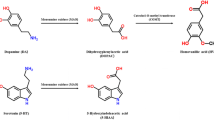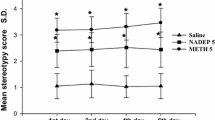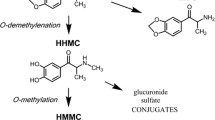Abstract
Purpose
Significant disturbances of the classical amphetamines on the dopamine (DA) and serotonin (5-HT) systems have been previously reported. However, few studies have been conducted on the effects of new psychoactive phenethylamines on the release of DA and 5-HT. In the present study, the effects of new psychoactive phenethylamines with a variety of aromatic ring substitutions (5-API, 3-FMA, 5-MAPB, and DMMA) on the release of DA and 5-HT were investigated.
Methods
Changes of DA, 5-HT and their metabolites in brain microdialysates from rats following exposure to the drugs were examined using a validated liquid chromatography–tandem mass spectrometry method. Their potencies of DA and 5-HT uptake inhibition as well as dopamine transporter (DAT) and serotonin transporter (SERT) binding were also determined.
Results
With the exception of DMMA, the drugs markedly affected the extracellular concentration of DA, 5-HT and/or their metabolites in rats and acted as potent inhibitors for DAT and/or SERT. Especially, 5-API potently induced the nonselective release of both DA and 5-HT, which was strongly correlated with a high degree of uptake inhibition and binding affinity to DAT and SERT. The 3-FMA, a methamphetamine analog with a halogen-substituted benzene, induced greater 5-HT release than DA.
Conclusions
We found that new psychoactive phenethylamines, with a variety of aromatic ring substitutions, affected the extracellular levels of DA, 5-HT, and/or their metabolites in the nucleus accumbens of rats to varying degrees and in different ways. The current results may assist further research into monoamine neurotransmitter-related mechanisms of new psychoactive phenethylamines.
Graphical abstract




Similar content being viewed by others
References
Kersten BP, McLaughlin ME (2015) Toxicology and management of novel psychoactive drugs. J Pharm Pract 28:50–65. https://doi.org/10.1177/0897190014544814
Nelson ME, Bryant SM, Aks SE (2014) Emerging drugs of abuse. Dis Mon 60:110–132. https://doi.org/10.1016/j.disamonth.2014.01.001
Rivera JV, Vance EG, Rushton WF, Arnold JK (2017) Novel psychoactive substances and trends of abuse. Crit Care Nurs Q 40:374–382. https://doi.org/10.1097/CNQ.0000000000000174
Hill SL, Thomas SH (2011) Clinical toxicology of newer recreational drugs. Clin Toxicol 49:705–719. https://doi.org/10.3109/15563650.2011.615318
Gingrich JA, Hen R (2001) Dissecting the role of the serotonin system in neuropsychiatric disorders using knockout mice. Psychopharmacology 155:1–10 (PMID: 11374326)
Sanders-Bush E, Hazelwood L (2011) 5-Hydroxytryptamine (serotonin) and dopamine. In: Brunton LL, Chabner BA, Knollmann BC (eds) Goodman & Gilman’s pharmacological basis of therapeutics, 12th edn. McGraw-Hill, New York, pp 335–361
Courtney KE, Ray LA (2014) Methamphetamine: an update on epidemiology, pharmacology, clinical phenomenology, and treatment literature. Drug Alcohol Depend 143:11–21. https://doi.org/10.1016/j.drugalcdep.2014.08.003
Lyles J, Cadet JL (2003) Methylenedioxymethamphetamine (MDMA, Ecstasy) neurotoxicity: cellular and molecular mechanisms. Brain Res Rev 42:155–168 (PMID: 12738056)
Kim M, Kim DH, Lee YS, Jang C-G, Yang CH, Lee S (2017) Changes in dopamine, serotonin and their metabolites in brain microdialysates from rats following exposure to new psychoactive drugs. Forensic Toxicol 35:66–76. https://doi.org/10.1007/s11419-016-0335-8
Zhao RJ, Yoon SS, Lee BH, Kwon YK, Kim KJ, Shim I, Choi K-H, Kim MR, Golden GT, Yang CH (2006) Acupuncture normalizes the release of accumbal dopamine during the withdrawal period and after the ethanol challenge in chronic ethanol-treated rats. Neurosci Lett 395:28–32. https://doi.org/10.1016/j.neulet.2005.10.043
Kim M, Lee JG, Yang CH, Lee S (2016) Silica stationary phase-based on-line sample enrichment coupled with LC–MS/MS for the quantification of dopamine, serotonin and their metabolites in rat brain microdialysates. Anal Chim Acta 923:55–65. https://doi.org/10.1016/j.aca.2016.03.021
Paudel S, Cao Y, Guo S, An B, Kim KM, Cheon SH (2015) Design and synthesis of 4-benzylpiperidine carboxamides as dual serotonin and norepinephrine reuptake inhibitors. Bioorg Med Chem 23:6418–6426. https://doi.org/10.1016/j.bmc.2015.08.022
Torres GE, Yao WD, Mohn AR, Quan H, Kim KM, Levey AI, Staudinger J, Caron MG (2001) Functional interaction between monoamine plasma membrane transporters and the synaptic PDZ domain-containing protein PICK1. Neuron 30:121–134 (PMID: 11343649)
Wigestrand MB, Stenberg M, Walaas SI, Fonnum F, Andersson PL (2013) Non-dioxin-like PCBs inhibit [3H]WIN-35,428 binding to the dopamine transporter: a structure-activity relationship study. Neurotoxicology 39:18–24. https://doi.org/10.1016/j.neuro.2013.07.005
Kim Y, Tae J, Lee K, Rhim H, Choo IH, Cho H, Park W-K, Keum G, Choo H (2014) Novel N-biphenyl-2-ylmethyl 2-methoxyphenylpiperazinylalkanamides as 5-HT7R antagonists for the treatment of depression. Bioorg Med Chem 22:4587–4596. https://doi.org/10.1016/j.bmc.2014.07.026
Brinkø A, Larsen MT, Koldsø H, Besenbacher L, Kolind A, Schiøtt B, Sinning S, Jensen HH (2016) Synthesis and inhibitory evaluation of 3-linked imipramines for the exploration of the S2 site of the human serotonin transporter. Bioorg Med Chem 24:2725–2738. https://doi.org/10.1016/j.bmc.2016.04.039
Marusich JA, Antonazzo KR, Blough BE, Brandt SD, Kavanagh PV, Partilla JS, Baumann MH (2016) The new psychoactive substances 5-(2-aminopropyl)indole (5-IT) and 6-(2-aminopropyl)indole (6-IT) interact with monoamine transporters in brain tissue. Neuropharmacology 101:68–75. https://doi.org/10.1016/j.neuropharm.2015.09.004
Luethi D, Kolaczynska KE, Docci L, Krahenbuhl S, Hoener MC, Liechti ME (2017) Pharmacological profile of mephedrone analogs and related new psychoactive substances. Neuropharmacology 134:4–12. https://doi.org/10.1016/j.neuropharm.2017.07.026
Shimshoni JA, Winkler I, Golan E, Nutt D (2017) Neurochemical binding profiles of novel indole and benzofuran MDMA analogues. Naunyn Schmiedebergs Arch Pharmacol 390:15–24. https://doi.org/10.1007/s00210-016-1297-4
Herraiz T, Brandt SD (2014) 5-(2-Aminopropyl)indole (5-IT): a psychoactive substance used for recreational purposes is an inhibitor of human monoamine oxidase (MAO). Drug Test Anal 6:607–613. https://doi.org/10.1002/dta.1530
Rickli A, Hoener MC, Liechti ME (2015) Monoamine transporter and receptor interaction profiles of novel psychoactive substances: para-halogenated amphetamines and pyrovalerone cathinones. Eur Neuropsychopharmacol 25:365–376. https://doi.org/10.1016/j.euroneuro.2014.12.012
Nguyen P-T, Shin E-J, Dang D-K, Tran H-Q, Jang C-G, Jeong JH, Lee YJ, Lee HJ, Lee YS, Yamada K, Nabeshima T, Kim H-C (2018) Role of dopamine D1 receptor in 3-fluoromethamphetamine-induced neurotoxicity in mice. Neurochem Int 113:69–84. https://doi.org/10.1016/j.neuint.2017.11.017
Fuwa T, Suzuki J, Tanaka T, Inomata A, Honda Y, Kodama T (2016) Novel psychoactive benzofurans strongly increase extracellular serotonin level in mouse corpus striatum. J Toxicol Sci 41:329–337. https://doi.org/10.2131/jts.41.329
Montgomery T, Buon C, Eibauer S, Guiry PJ, Keenan AK, McBean GJ (2007) Comparative potencies of 3,4-methylenedioxymethamphetamine (MDMA) analogues as inhibitors of [3H]noradrenaline and [3H]5-HT transport in mammalian cell lines. Br J Pharmacol 152:1121–1130. https://doi.org/10.1038/sj.bjp.0707473
Acknowledgements
This research was supported by grants from the Ministry of Food and Drug Safety (14182MFDS979 and 16182MFDS417) and by the Basic Science Research Program through the National Research Foundation of Korea (NRF) funded by the Ministry of Education (NRF-2016R1A6A1A03011325).
Author information
Authors and Affiliations
Corresponding authors
Ethics declarations
Conflict of interest
The authors declare that they have no conflicts of interest.
Ethical approval
This article does not contain any studies with human participants performed by any of the authors. All animal experiments were approved of the Institutional Animal Care and Use Committee at Daegu Haany University.
Rights and permissions
About this article
Cite this article
Kim, M., Yang, C.H., Lee, Y.S. et al. Effects of aromatic ring-substituted phenethylamines on the release of dopamine and serotonin. Forensic Toxicol 37, 104–112 (2019). https://doi.org/10.1007/s11419-018-0440-y
Received:
Accepted:
Published:
Issue Date:
DOI: https://doi.org/10.1007/s11419-018-0440-y




